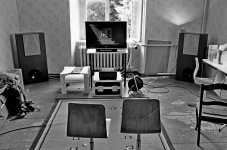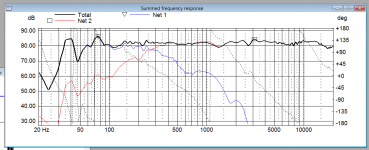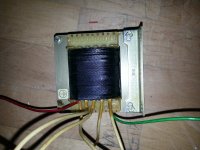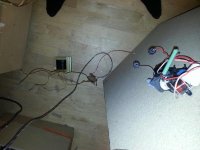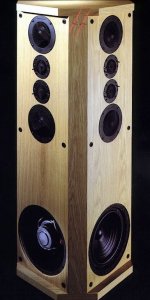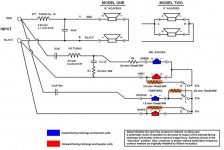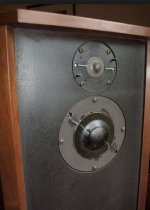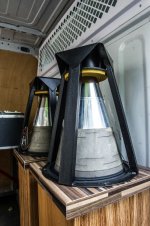Oh, yes. I was always fascinated by the way the Coles 4001 supertweeter started life as an ITT microphone.
Can I draw you off-topic with the endlessly interesting Beyond the Ariel thread?
TBH, I think Lynn Olson is struggling to think of the next step here. And, hey Lynn, step in here if I'm talking rubbish. 😱
But I have established, at least to my own satisfaction, that the Ariel's D'Appolito, aka MTM idea, is actually broken. A simple question of power falloff with distance. Cylindrical waves versus spherical waves an' all that stuff. But this huge horn stuff with huge JBL woofers is a bit of a weird change of direction. Like my favourite simulation of a Black Hole, which I just throw in because it's interesting, and also because a post without a picture is boring IMO.
I know you aren't too impressed with MTM. The Ariel was nevertheless beautiful at many levels. Even if it was beyond my capabilities with carpentry, and the little Vifa P13WH polycone drivers are unobtainable now. I also don't like parallel wired MTM because the woofers can interact unpleasantly.
I thought Troels did some amazing work on his ScanSpeak-3W-Discovery. Even if his curves were a bit sub-optimal in Steen Duelund terms.
My own thought is that Lynn should have just EVOLVED to an MTTM, which in my opinion works better on theoretical grounds. But I also respect the high efficiency ideal.
What do you make of it, if it is politic to say? 🙂
Can I draw you off-topic with the endlessly interesting Beyond the Ariel thread?
TBH, I think Lynn Olson is struggling to think of the next step here. And, hey Lynn, step in here if I'm talking rubbish. 😱
But I have established, at least to my own satisfaction, that the Ariel's D'Appolito, aka MTM idea, is actually broken. A simple question of power falloff with distance. Cylindrical waves versus spherical waves an' all that stuff. But this huge horn stuff with huge JBL woofers is a bit of a weird change of direction. Like my favourite simulation of a Black Hole, which I just throw in because it's interesting, and also because a post without a picture is boring IMO.
An externally hosted image should be here but it was not working when we last tested it.
I know you aren't too impressed with MTM. The Ariel was nevertheless beautiful at many levels. Even if it was beyond my capabilities with carpentry, and the little Vifa P13WH polycone drivers are unobtainable now. I also don't like parallel wired MTM because the woofers can interact unpleasantly.
I thought Troels did some amazing work on his ScanSpeak-3W-Discovery. Even if his curves were a bit sub-optimal in Steen Duelund terms.
My own thought is that Lynn should have just EVOLVED to an MTTM, which in my opinion works better on theoretical grounds. But I also respect the high efficiency ideal.
What do you make of it, if it is politic to say? 🙂
I tried this and it works :Audio and Loudspeaker Design Guide Lines
That guy is apita but anyway.
The discovery drivers are very good value. Hard to beat in ballance.
That guy is apita but anyway.
The discovery drivers are very good value. Hard to beat in ballance.
Doesn't that configuration produce excessive lobing? As level changes in each speaker, phase also changes the oposite way. If I were to want to use this philosophy to frequency taper a strait line array, would I end up with a virtual curve backwards?I tried this and it works :Audio and Loudspeaker Design Guide Lines
That guy is apita but anyway.
The discovery drivers are very good value. Hard to beat in ballance.
I made an openbaffle with two Neo 10 th an a Mundorf AMT in the middle that works very well.
Unfortunately i can not post the speaker because it is propriatary work for a customer.
Unfortunately i can not post the speaker because it is propriatary work for a customer.
Today i got two Auto Formers.
Using them i can transform the 8 Ohm woofer to 4 Ohm.
That way i get more voltage sensitivity on the woofer ( 3dB )
I hope i can make a passive version of the German Speaker that way.
I can even transform to 2 Ohm for a voltage gain of 6dB but that needs a stable amplifier.
Using them i can transform the 8 Ohm woofer to 4 Ohm.
That way i get more voltage sensitivity on the woofer ( 3dB )
I hope i can make a passive version of the German Speaker that way.
I can even transform to 2 Ohm for a voltage gain of 6dB but that needs a stable amplifier.
I have now made a passive version that stays over 3 Ohm.
I will order some parts and when it playes like expected i tell you more.
I will order some parts and when it playes like expected i tell you more.
Looking forward to seeing this Joachim.
You've really made me think about floor bounce and the Allison Effect. Troels is getting it here at 250Hz with his Poor Man's Strad:
Poor Man'
He's also getting some boom from a reflex curve interacting with room gain, which is something you mentioned before in favour of closed box with near 12dB rolloffs. I do think that 3 ways are really hard. The theory from Steen Duelund seems to say you use 4th order filters throughout, just they look like 2nd order slopes on the wide bandwidth mid. Flat baffle seems to be a game changer though.
I looked at Roy Allison's lovely IC20 design, and see that he goes for series wired with MTTM. Which makes sense to me with a shared enclosure to avoid the drivers interacting. Also the unique Gaussian mid and tweeter profiles.
I really don't know about your horizontal array of mids. It might make sense in some way. Edgar Villchur did it in the AR MST:
That was also a dispersion matter with cone tweeters too. But there is nothing like actually doing it!
You've really made me think about floor bounce and the Allison Effect. Troels is getting it here at 250Hz with his Poor Man's Strad:
Poor Man'
He's also getting some boom from a reflex curve interacting with room gain, which is something you mentioned before in favour of closed box with near 12dB rolloffs. I do think that 3 ways are really hard. The theory from Steen Duelund seems to say you use 4th order filters throughout, just they look like 2nd order slopes on the wide bandwidth mid. Flat baffle seems to be a game changer though.
I looked at Roy Allison's lovely IC20 design, and see that he goes for series wired with MTTM. Which makes sense to me with a shared enclosure to avoid the drivers interacting. Also the unique Gaussian mid and tweeter profiles.
I really don't know about your horizontal array of mids. It might make sense in some way. Edgar Villchur did it in the AR MST:
An externally hosted image should be here but it was not working when we last tested it.
That was also a dispersion matter with cone tweeters too. But there is nothing like actually doing it!
Attachments
Wow, that Model One has even push-pull woofers for second harmonic cancelation.
There is nothing new under the sun
king salomon
There is nothing new under the sun
king salomon
TBH, I think Lynn Olson is struggling to think of the next step here. And, hey Lynn, step in here if I'm talking rubbish. 😱
But I have established, at least to my own satisfaction, that the Ariel's D'Appolito, aka MTM idea, is actually broken. A simple question of power falloff with distance. Cylindrical waves versus spherical waves an' all that stuff. But this huge horn stuff with huge JBL woofers is a bit of a weird change of direction.
I know you aren't too impressed with MTM. The Ariel was nevertheless beautiful at many levels. Even if it was beyond my capabilities with carpentry, and the little Vifa P13WH polycone drivers are unobtainable now. I also don't like parallel wired MTM because the woofers can interact unpleasantly.
I thought Troels did some amazing work on his ScanSpeak-3W-Discovery. Even if his curves were a bit sub-optimal in Steen Duelund terms.
My own thought is that Lynn should have just EVOLVED to an MTTM, which in my opinion works better on theoretical grounds. But I also respect the high efficiency ideal.
What do you make of it, if it is politic to say? 🙂
Hi there, System7! No offense taken, don't worry. I agree that MTM's have serious problems ... the trouble getting the subjective balance to match the measured FR was a hint that changes in directivity was causing problems.
There was always a desire to design a more modern version of the Ariel, which is 21 years old now. But direct-radiator drivers didn't get more efficient, like I was hoping they would. It didn't seem worth it to design a new speaker and end up with an efficiency only 1 or 2 dB higher than the Ariel.
I see your point about MTTM speakers. The directivity index between pairs of tweeters and pairs of woofers is similar, although I'm concerned about venetian-blind lobing as the listener makes slight vertical moves up and down. The last time I tried stacked tweeters, I could hear interference effects when listening with pink-noise (or choral music). I'm very sensitive to diffraction and interference effects, and don't like them ... they sound very artificial and "electronic" to me.
I've seen your post about Gaussian spatial distributions ... I agree completely. My mentors at Tektronix walked me through how RF antennas have an identity between lobes in the pulse response, ripples in the group-delay response, and lobes in the polar response. Build a Yagi antenna, and it will be as highly directional as desired, but it will also have restricted bandwidth, group-delay ripples (which affects the phase response of color TV and stereo FM subcarriers), and sharp unwanted lobes in the polar response.
By contrast, a simple dipole antenna only has moderate figure-eight directivity, but broader bandwidth, and freedom from ripples in the time and spatial domain. Modern log-periodic antennas optimize all of the domains, while minimizing time and spatial ripples.
The same issues arise in loudspeakers. The physical problems that cause ripples in the time domain also create lobes in the polar pattern ... reflections, diffraction, energy storage in the drivers, horn modes, etc.
My reservations about OB's, aside from power-handling, is the rear wave wrapping around the edge of the OB and creating an inverted, time-delayed, and low-passed version of the first-arrival sound. This can be equalized out, true, but it doesn't get rid of the time-delayed second signal. It would take digital FIR processing to cancel the secondary arrival, and I can only guess what the resulting polar pattern would look like.
Similarly, the problem I see with the Allison design is the secondary arrival from the tweeters on the "far side" of the enclosure ... about a half-millisecond later, at a guess.
Last edited:
For example this :Rectilinear Research Corporation - Wikipedia, the free encyclopedia
As far as i understand the multiple tweeters where supposed to partly cancel the combfilter effect caused by listening with two ears to two speakers ( Stereo ) by actually producing combfiltering of the opposite gender.
How this actually works and how that works i do not know.
I would like to do some research in that direction but i do not know where to start.
As far as i understand the multiple tweeters where supposed to partly cancel the combfilter effect caused by listening with two ears to two speakers ( Stereo ) by actually producing combfiltering of the opposite gender.
How this actually works and how that works i do not know.
I would like to do some research in that direction but i do not know where to start.
http://www.linkwitzlab.com/Horbach-Keele Presentation Part 2 V4.pdf
This DSP controlled speaker is one way to solve the problems with MTM.
It is very strict and complex.
This DSP controlled speaker is one way to solve the problems with MTM.
It is very strict and complex.
For example this: Rectilinear Research Corporation - Wikipedia, the free encyclopedia
As far as I understand the multiple tweeters where supposed to partly cancel the comb filter effect caused by listening with two ears to two speakers (Stereo) by actually producing comb filtering of the opposite gender.
How this actually works and how that works I do not know. I would like to do some research in that direction but i do not know where to start.
Back when dinosaurs walked the Earth, I used to sell these at Pacific Stereo in Los Angeles. The imaging was very poor, but on the positive side, the 2.25" Peerless cone tweeters were very sweet sounding, not harsh like majority of dome tweeters in the early Seventies. A single Peerless cone tweeter didn't have enough power-handling (unless it was crossed very high at 5 kHz), but if you used them in groups (of at least two), there was no problem with overload.
The Peerless cone tweeters were the sweetest tweeters you could get until the first Scan-Speak silk-dome tweeters came out. With the exception of RTR and JansZen electrostats, the other tweeters of the day had much rougher responses, and didn't "play well" with early transistor amplifiers. Back then, the Phase Linear 700 and Crown DC300 were considered advanced designs, and they certainly ate their share of tweeters.
Speakers with good imaging were very rare. Only the most sophisticated British speakers were manufactured in mirror-imaged pairs, diffraction control was unknown, and American crossovers were primitive (typically only a level control and a series-cap for the tweeter).
Sorry to break any illusions, but I also sold the AR LST (predecessor to the Allison), and the imaging was noticeably more diffuse and vague than the Advent, which was half the price. We didn't sell very many of them, to be honest. Maybe one pair during the year I was there.
The ones that flew out the door were the JBL L100's, the Advents, and a fair number of Bose 901's (first edition). Although we knock 901's today for diffuse imaging, the imaging on most bookshelf speakers, with asymmetric tweeter locations that were not mirror-imaged, was just as bad, and the 901's also sounded a lot more spacious than the competitors. One of the demonstrations we did for our customers was aim a pair of Advents right at each other, space them from the rear wall at the Bose-recommended distance of 20~24", and A/B compare them to the 901's. They sounded more alike than you might expect.
Memory may not serve well, but I think the best-imaging (American) speakers of the day were the Ohm series of speakers with the famous Walsh tweeter.
Last edited:
In the 70th i had Ohm F .
As far as i remember they had great bass and imaging.
They where a little dark and ate power.
My Quad 405 got so hot that i could fry eggs.
As far as i remember they had great bass and imaging.
They where a little dark and ate power.
My Quad 405 got so hot that i could fry eggs.
I then bought this one :Dynaco Stereo 400 Power Amplifier Component Info
It worked much better with the Ohm F´s.
I think the output stage was cascoded. Maybe a Bongiorno design.
Funny, i just listened to a restored Ohm F with some improvements and it sounded great.
The highs where really extended and well resolved in that version.
It worked much better with the Ohm F´s.
I think the output stage was cascoded. Maybe a Bongiorno design.
Funny, i just listened to a restored Ohm F with some improvements and it sounded great.
The highs where really extended and well resolved in that version.
- Status
- Not open for further replies.
- Home
- Loudspeakers
- Multi-Way
- The Quintessentially German Loudspeaker of the 70th. Modern Interpretation.
